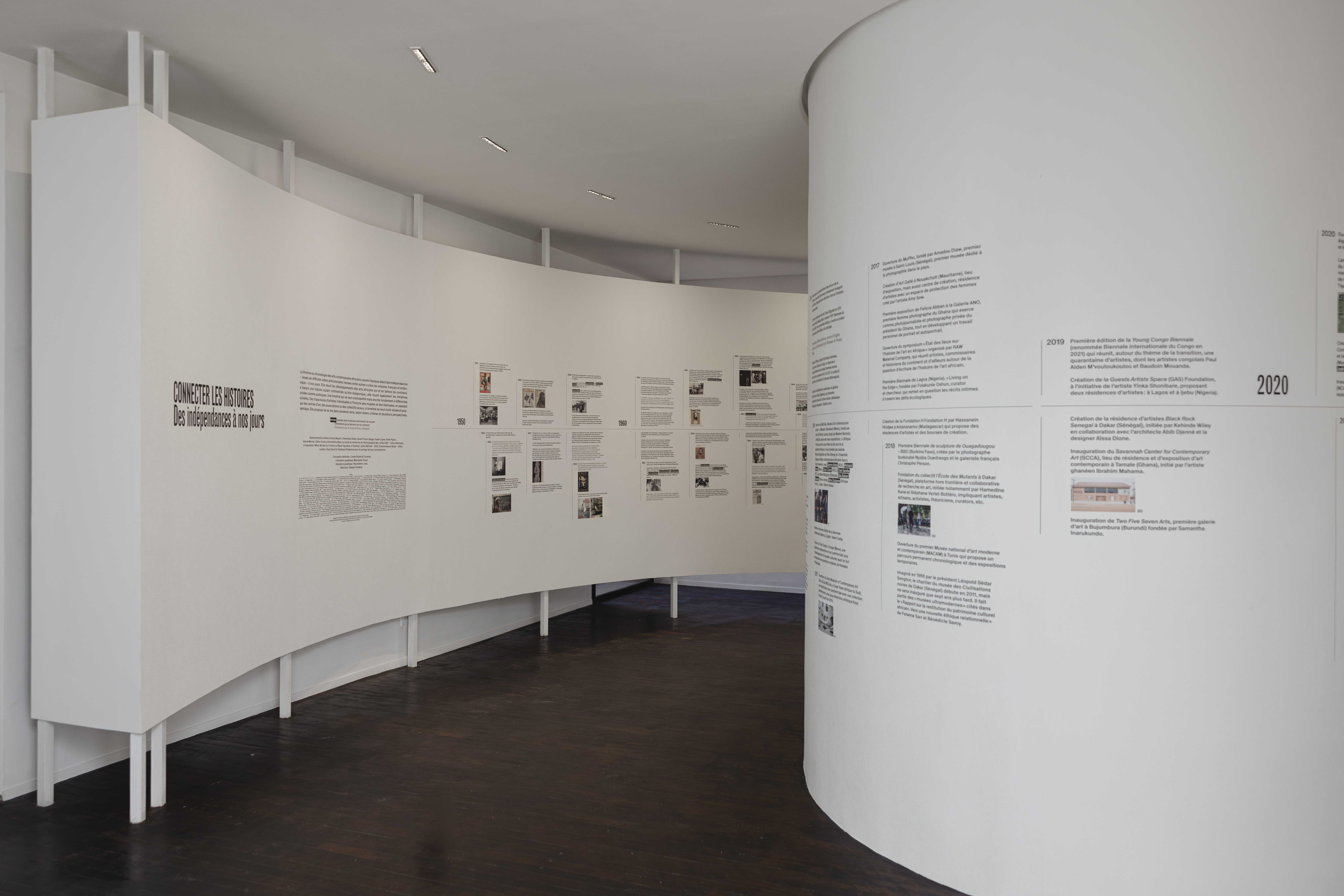ربط تواريخ الاستقلال بيومنا هذا
Connecting histories from Independence to the present day
يغطي الخط الزمني أو التسلسل الزمني للفنون المعاصرة الأفريقية الحقبة الممتدة من الاستقلال – الذي جاء نتيجة نضالات صعبة ضد الاستعمار، ولا سيما ضد الإمبراطوريتين الفرنسية والبريطانية – وحتى يومنا هذا. فهو يجمع بين تطورات الفنون الأفريقية داخل القارة وخارجها، من خلال سردية تربط بين التاريخ القاري والتاريخ الأفرو-دياسبوري، وتشمل كلًّا من المبادرات الخاصة والعامة. يسعى هذا التسلسل الزمني إلى أن يكون كوزموبوليتيًا لكنه متجذر محليًا على مستويات مختلفة. فمن المسارات الفردية للفنانين إلى تاريخ المتاحف والبيناليات، مرورًا بمراكز الفنون والجمعيات والتجمعات المحلية، يهدف إلى أن يكون متعدد المواقع ومتعدد الدلالات. وهو يطمح إلى أن يُقرأ وفق اتجاهات متعددة، بناءً على معايير متنوعة ومن زوايا نظر مختلفة.
The timeline of contemporary African art stretches from the hard-won days of independence–the culmination of difficult anticolonial struggles led against French and British colonial powers–to now. This chronology brings together the development of African art from the continent and beyond, through a history that is continental as well as Afro-diasporic, featuring both private and public initiatives. Though cosmopolitan, the timeline is locally rooted at varying scale. From the trajectories of individual artists to the history of museums and biennials as well as art centres, organisations, and local collectives, the timeline is intended to be polysemous and multi-situated. It is meant to be read in different ways, through diverse criteria and multiple perspectives.

سامي بالوجي - "كاسالا: مسلخ الأحلام أو الإنسان الأول، خطأ بندي"، 2020
Sammy Baloji - Kasala: the Slaughterhouse of Dreams or the First Human, Bende’s Error, 2020
سامي بالوجي Sammy Baloji فنان متعدد الوسائط معروف بقدرته على استكشاف أرشيفات الاستعمار وزعزعة سلطتها، لإبراز الروايات التي تتجاهلها. كاسالا: مسلخ الأحلام أو الإنسان الأول، خطأ بندي يجمع مجموعة من الأعمال، بما في ذلك الفيديو-الأداء المقدم هنا، إلى جانب كولاجات رقمية (تظهر في الفيديو) مأخوذة من أرشيفات ومجموعات متحف الإثنوغرافيا ريتبرغ في زيورخ. يواجه الفنان هذه الأرشيفات بممارسات نقل ثقافة اللوبا (من إمبراطورية لوبا التي امتدت عبر جمهورية الكونغو الديمقراطية الحالية من القرن الـ 16 إلى القرن الـ 19).
Sammy Baloji is a multimedia artist known for his ability to draw on archives of colonisation in order to undermine their authority and bring to light the stories they conceal. Kasala: the Slaughterhouse of Dreams or the First Human, Bende’s Error brings together a body of work that includes the video-performance presented here, as well as digital collages (present in the video) created from the archives and collections of the Rietberg Museum of Ethnography in Zürich. The artist confronts these traces with Luba cultural transmission practices (from the Luba empire, which extended over what is now the Democratic Republic of Congo from the 16th to the 19th centuries).
يتألف الأداء الموسيقي من سرد مضاد يقدمه سامي بالوجي ضد نظام المتحف الإثنوغرافي، الذي يقتلع القطع الأثرية الإفريقية ويفصلها عن استخداماتها ومعانيها الثقافية. لتحقيق ذلك، دعا الفنان الكاتب الكونغولي فيستون موانزا موجيلا Fiston Mwanza Mujila لكتابة "كاسالا" – وهو شعر لوبا يدمج عناصر جينية، أسطورية، كونية، وتاريخية – بمرافقة موسيقيين اثنين، باتريك دونست Patrick Dunst وغريلي بولهايمر Grilli Pollheimer. تعمل تلاوات فيستون موانزا موجيلا على القطع الأثرية في المتحف كأنها ترنيمة طقسية فدائية. تعبر هذه التلاوات عن معاناة عمال المناجم الحرفيين في كاتانغا، والقمع الدموي لحركات التحرير، والاغتيالات السياسية، وغيرها من الأوجاع المتجذرة في التاريخ الكونغولي. صوته يرتفع تدريجيًا مع الآلات الموسيقية، يرتجف، يتردد، يهمس، ويتلاشى في سرد مضطرب لماضٍ عنيف.
The musical performance is Sammy Baloji's counter-narrative to the ethnographic museum system, which uproots African artefacts by separating them from their cultural uses and meanings. To this end, the artist invited the Congolese writer Fiston Mwanza Mujila to write a ‘Kasala’–a Luba poem combining genealogical, mythological, cosmogonic and historical elements– accompanied by two musicians, Patrick Dunst and Grilli Pollheimer. Fiston Mwanza Mujila's readings act on the museum artefacts like a redemptive ritual song.They express the suffering of the artisanal miners of Katanga, the bloody repression of liberation movements, political assassinations, and other pains rooted in Congolese history. His voice resonates in crescendo with the instruments, trembling, bouncing, whispering and exhausting itself in the turbulent tale of a violent past.





